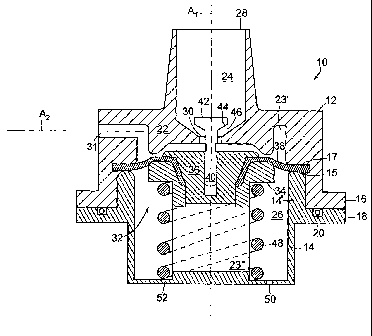Some of the information on this Web page has been provided by external sources. The Government of Canada is not responsible for the accuracy, reliability or currency of the information supplied by external sources. Users wishing to rely upon this information should consult directly with the source of the information. Content provided by external sources is not subject to official languages, privacy and accessibility requirements.
Any discrepancies in the text and image of the Claims and Abstract are due to differing posting times. Text of the Claims and Abstract are posted:
| (12) Patent: | (11) CA 2602306 |
|---|---|
| (54) English Title: | CONSTANT FLOW VALVE |
| (54) French Title: | VANNE A DEBIT CONSTANT |
| Status: | Granted and Issued |
| (51) International Patent Classification (IPC): |
|
|---|---|
| (72) Inventors : |
|
| (73) Owners : |
|
| (71) Applicants : |
|
| (74) Agent: | SMART & BIGGAR LP |
| (74) Associate agent: | |
| (45) Issued: | 2010-09-28 |
| (86) PCT Filing Date: | 2006-02-21 |
| (87) Open to Public Inspection: | 2006-09-28 |
| Examination requested: | 2007-09-20 |
| Availability of licence: | N/A |
| Dedicated to the Public: | N/A |
| (25) Language of filing: | English |
| Patent Cooperation Treaty (PCT): | Yes |
|---|---|
| (86) PCT Filing Number: | PCT/US2006/005941 |
| (87) International Publication Number: | WO 2006101641 |
| (85) National Entry: | 2007-09-20 |
| (30) Application Priority Data: | |||||||||
|---|---|---|---|---|---|---|---|---|---|
|
A regulating valve includes an outer housing (10) comprised of a cap (12)
joined to a base (14). The housing is internally subdivided by a barrier wall
(22) into a head section (24) and a base section (26), the latter being
further subdivided by a modulating assembly (32) into a fluid chamber (23')
and a spring chamber (23"). An inlet (28) and a 90~ outlet (31) in the cap
communicate with the fluid chamber. Fluid at a variable pressure is admitted
into the fluid chamber via the inlet, with the modulating assembly serving to
maintain the fluid exiting the fluid chamber via the outlet at a substantially
constant pressure.
La présente invention se rapporte à une vanne de réglage qui comprend un logement externe (10) constitué d'un bouchon (12) relié à une base (14). L'intérieur du logement est divisé, par une paroi barrière (22), en une section de tête (24) et une section de base (26), cette dernière étant elle-même divisée, par un ensemble de modulation (32), en une chambre de fluide (23') et une chambre à ressort (23''). Un orifice d'entrée (28) et un orifice de sortie (31) à 90° formés dans le bouchon communiquent avec la chambre de fluide. Le fluide à une pression variable est admis dans la chambre de fluide par l'intermédiaire de l'orifice d'entrée, l'ensemble de modulation servant à maintenir le fluide sortant de la chambre de fluide par l'orifice de sortie à une pression sensiblement constante.
Note: Claims are shown in the official language in which they were submitted.
Note: Descriptions are shown in the official language in which they were submitted.

2024-08-01:As part of the Next Generation Patents (NGP) transition, the Canadian Patents Database (CPD) now contains a more detailed Event History, which replicates the Event Log of our new back-office solution.
Please note that "Inactive:" events refers to events no longer in use in our new back-office solution.
For a clearer understanding of the status of the application/patent presented on this page, the site Disclaimer , as well as the definitions for Patent , Event History , Maintenance Fee and Payment History should be consulted.
| Description | Date |
|---|---|
| Common Representative Appointed | 2019-10-30 |
| Common Representative Appointed | 2019-10-30 |
| Change of Address or Method of Correspondence Request Received | 2018-03-28 |
| Maintenance Request Received | 2018-01-29 |
| Maintenance Request Received | 2017-01-30 |
| Maintenance Request Received | 2016-01-28 |
| Maintenance Request Received | 2014-01-28 |
| Maintenance Request Received | 2012-12-27 |
| Grant by Issuance | 2010-09-28 |
| Inactive: Cover page published | 2010-09-27 |
| Pre-grant | 2010-07-16 |
| Inactive: Final fee received | 2010-07-16 |
| Notice of Allowance is Issued | 2010-01-29 |
| Letter Sent | 2010-01-29 |
| Notice of Allowance is Issued | 2010-01-29 |
| Inactive: Approved for allowance (AFA) | 2010-01-26 |
| Amendment Received - Voluntary Amendment | 2009-12-23 |
| Inactive: S.30(2) Rules - Examiner requisition | 2009-06-30 |
| Letter Sent | 2008-01-11 |
| Inactive: Cover page published | 2007-12-12 |
| Inactive: Declaration of entitlement/transfer requested - Formalities | 2007-12-11 |
| Inactive: Acknowledgment of national entry - RFE | 2007-12-10 |
| Letter Sent | 2007-12-10 |
| Inactive: Correspondence - Formalities | 2007-11-19 |
| Inactive: Single transfer | 2007-11-05 |
| Inactive: First IPC assigned | 2007-10-25 |
| Application Received - PCT | 2007-10-24 |
| National Entry Requirements Determined Compliant | 2007-09-20 |
| Request for Examination Requirements Determined Compliant | 2007-09-20 |
| All Requirements for Examination Determined Compliant | 2007-09-20 |
| Application Published (Open to Public Inspection) | 2006-09-28 |
There is no abandonment history.
The last payment was received on 2010-01-22
Note : If the full payment has not been received on or before the date indicated, a further fee may be required which may be one of the following
Please refer to the CIPO Patent Fees web page to see all current fee amounts.
Note: Records showing the ownership history in alphabetical order.
| Current Owners on Record |
|---|
| GLOBAL AGRICULTURAL TECHNOLOGY AND ENGINEERING, LLC |
| Past Owners on Record |
|---|
| JOHN R. NEWTON |